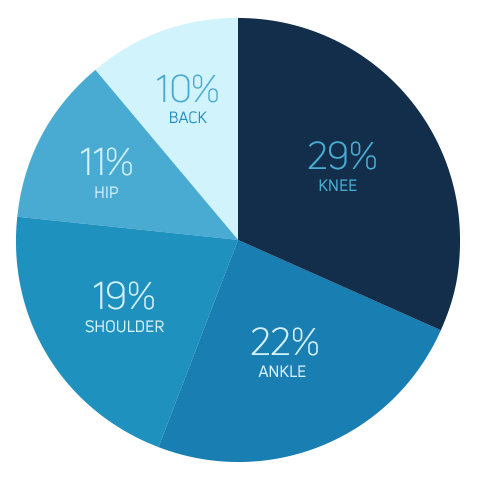Surf injuries are increasingly common and getting more attention as the sport grows in popularity.
As the Official Sports Brace of USA Surfing, DJO® is proud to support U.S. National Team surfers with bracing and durable goods products to help with injury prevention, education, and recovery.
According to research conducted by USA Surfing medical director Kevyn Dean, WSL medical director Dr. Warren Kramer, and orthopedic surgeon Dr. Eric Hohn, knee and ankle injuries are the most common injuries among the world’s most elite surfers. As they seek to understand the influx, reports of both professional and recreational surfers requiring time out of the water is increasing.
“We wanted to find out — are surfing injuries on the rise, or are we just becoming more aware of them?” - Dean
While surfers nowadays are performing bigger, riskier maneuvers as the sport progresses, this trend doesn’t account for much of the increased injuries. In fact, the majority of injuries presenting to medical professionals continue to be a result of everyday surfing, in mediocre waves, attempting non-aggressive maneuvers.
Common Surf Injuries
The research found five top areas injured along with the typical mechanisms reported.

Knee
At 29%, knee injuries are the most common, and like the hip, the most commonly involved side, was the back leg. Among these, the majority of the injuries are to the medial collateral ligament (MCL). As the largest hinge joint in the body, the knee flexes and extends forwards and back but often goes side-to-side when surfers driving off their dominant back leg place undue stress upon the MCL by forcing their knee sideways down to the board.
Ankle
Injuries to the ankle are second highest at 22% and the vast majority are moderate and high ankle sprains. This type of injury occurs when the top of the foot is driven up forcefully toward the tibia or when the foot is twisted sideways under the ankle, seen likely when landing hard during an air or floater.
Shoulder
About half of shoulder injuries, which make up 19% of overall injuries seen in surfing, involve joint instability. For surfers, when the shoulder joint is forced beyond its anatomical limits during activities such as grabbing the water to stall, or the arm gets stuck in the water during a fall, instability often results.
Hip
Most of the injuries that make up the 11% to the hip are due to the impingement of the soft tissue lining the socket when the leg is brought forward and rotated in-ward in a typical surf stance.
Back
While back injuries make up the smallest portion (10%), the majority are lumbar sprains that occur when the low back is forced into positions beyond its anatomical limits. While typical core stability can help, one must consider anatomical limitations that are put in place by recurring surf movements. Since surfing is a unilateral sport, where a surfer has a consistent stance comprised of one foot forward, while the body is rotated slightly toward the front leg, a trunk rotation asymmetry often occurs. This can result in the trunk forcibly rotating against the asymmetry, resulting in low back sprains.

Prevention
Identifying the reasons behind the increase in surf injuries for both competitive athletes and recreational surfers, is essential to addressing prevention. Dean emphasizes the importance of taking proactive mesures and having a heightened awareness of movement in the sport.
“Surfers should work with trainers and physical therapists who watch them surf or at least watch film of them surfing, so they can see and understand the movement patterns unique to each surfers,” Dean says. “Our goal in identifying commonalities is to start a conversation and raise awareness about which injuries are on the rise and why.”
Strength Training
While strength training is important for improving performance and preventing injury, it should be accompanied by attention to movement patterns. Moving correctly, avoiding positions that put surfers at risk, and staying within anatomical limitations are foundational keys to athletic training.
“This is overlooked far too often,” Dean warns. “Yes, physical conditioning increases power allowing an athlete to push harder, however, building strength on top of poor movement puts an athlete in compromised positions with increased force. Traumatic breakdown becomes inevitable. Strength is important, but proper movement as a foundation is imperative for preventing injury.”

Overuse
Overuse is another emerging culprit. Now that wave pools are on the rise, surfers are able to take advantage of more time in the water. However, this allows for more repetitions in compromised positions lead to injury.
Recovery
As USA Surfing’s Medical Director, Dean speaks to surfers about the role recovery and rehab efforts play in keeping athletes strong and healthy. He continues to share emerging findings about how surfing injuries take place and how to address and prevent them.
For many, the increased down time led to more rest, more attention to film review and technique, equipment tweaks and smarter training — all having the potential to reduce injuries.
As the science of surfing performance advances, more will be known about injury prevention and rehabilitation so that surfers can stay in the water doing what they love.
Shop all recommended surf braces
Learn more about the national governing body of the sport of surfing in the U.S.: https://www.usasurfing.org/
USA Surfing is a partner of DJO®. DJO does not directly sponsor individual National Team athletes.
The opinions expressed are independently prepared and for informational purposes only. They are not necessarily indicative of the views of any other party.